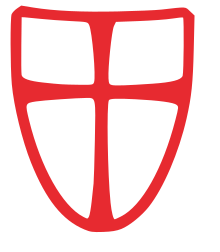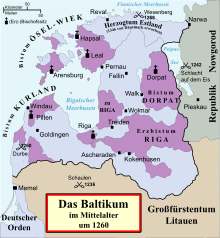Brothers of the Sword Order
The Order of the Brothers of the Sword ( Latin: Fratres miliciae Christi de Livonia , in German: Brothers of the Knighthood of Christ of Livonia ) was a spiritual order of knights . It was founded in 1202 by Theodorich von Treiden on the initiative of Bishop Albert I of Riga for the mission of Livonia (Latvian: Vidzeme ). After initial successes in the first decades of the 13th century, the order was incorporated into the Teutonic Order together with its remaining members in 1237 after the heavy defeat at Schaulen against the Lithuanians .
history

Pope Innocent III confirmed the Order of the Brothers of the Sword in 1204 and obliged its masters to obey the Bishop of Riga (later Archbishop). In 1215 the Sword Brothers took Dorpat , and in 1227 the Estonian island of Ösel followed .
The order was committed to the younger Templar rule ; Its members lived according to the evangelical councils , that is, they had to live under Spartan conditions, practice chastity and obey the master of the order . The order divided its members into three classes, namely knights, priests and serving brothers. The knights wore a white cloak over a white tunic with the symbol of the order, a red sword cross, from which the name "sword brothers" results. Brother priests wore a white robe, brothers serving in black or brown clothing, each with the mark of the order.
The first master of the sword order was Vinno von Rohrbach 1202-1209, resident in the order castle from Wenden to Livonia . His successor was Volquin Schenk von Winterstedt , he died on September 21, 1236. The Order of the Brothers of the Sword quickly conquered all of Livonia and Estonia . Contrary to the papal requirement, the order soon made itself independent of the bishop. In 1207 the Sword Brothers contracted a third of the conquered land. The ongoing rivalry between Bishop Albert and the order culminated in an arbitration ruling by the Pope in 1210, which granted the order even more extensive rights.
An alliance concluded against the bishop with King Waldemar II of Denmark turned in the conflict over Reval , today's Tallinn, to the detriment of the order. The recognition of the Danish claims by Gregory IX. in 1236 accelerated the gradual decline of the order. The end point was a devastating defeat in the Battle of Schaulen in 1236, which took place either in today's Lithuanian Šiauliai (German Schaulen, Lat. Saule) or in the Latvian Vecsaule. Both master masters and the "domineers" as well as a large number of combatable knights and followers had fallen. The Lithuanians, however, continued to advance and threaten Riga. In view of the immediate "pagan" threat from the Lithuanians, there was only one way out: According to a papal arbitration in 1237, the remaining Sword Brothers were united with the Teutonic Order in the Viterber Union . Her property was transferred to the Teutonic Order while maintaining its own Livonian administration .
The Order of the Brothers of the Sword as namesake
An organization called the “Livland Order of the Brothers of the Sword” was re-established by Josef Pongratz (Josephus von Schwarzenberg) in 1956 in Rosenheim. There is nothing more than an ideal reference to the Order of the Sword Brothers. The organization has branches in various forms in Germany, France, the Netherlands, Austria, America and South Africa.
literature
- Friedrich Benninghoven : The order of the sword brothers. Fratres milicie Christi de Livonia (= East Central Europe in the past and present. Vol. 9). Böhlau, Cologne a. a. 1965.
- Alain Demurger: The Knights of the Lord. History of the spiritual orders of knights. CH Beck, Munich 2003, ISBN 3-406-50282-2 .
- Wolfgang Sonthofen: The German Order. Weltbild, Augsburg 1995, ISBN 3-89350-713-2 .
- Dieter Zimmerling: The German order of knights. Econ, Munich 1998, ISBN 3-430-19959-X .
- Ilgvars Misāns: “We have always been a warrior people”. The representation of the East Baltic Crusades in Latvian historiography . In: Jutta Prieur (Ed.): Lippe and Livland. Medieval rulership under the sign of the rose. Publishing house for regional history, Gütersloh 2008, ISBN 978-3-89534-752-8 , pp. 185–207.
Remarks
- ↑ See Friedrich Wilhelm Bautz: ALBERT von Buxhövden. In: Biographisch-Bibliographisches Kirchenlexikon (BBKL). Volume 1 (1990), Bautz,, Sp. 81.
- ^ Ernst Friedrich Mooyer: Directories of the German bishops since the year 800 AD , Minden 1854, p. 148
- ↑ a b Hartmut Boockmann : The German Order. 12 chapters from its history. Munich 1981.
- ↑ Johanna Blum: Brothers of the sword are benefactors. In: inFranken.de
- ^ "Order of Knights of the Brothers of the Sword of Livonia zue Ostarrichi, Supreme Convention" from 1990

